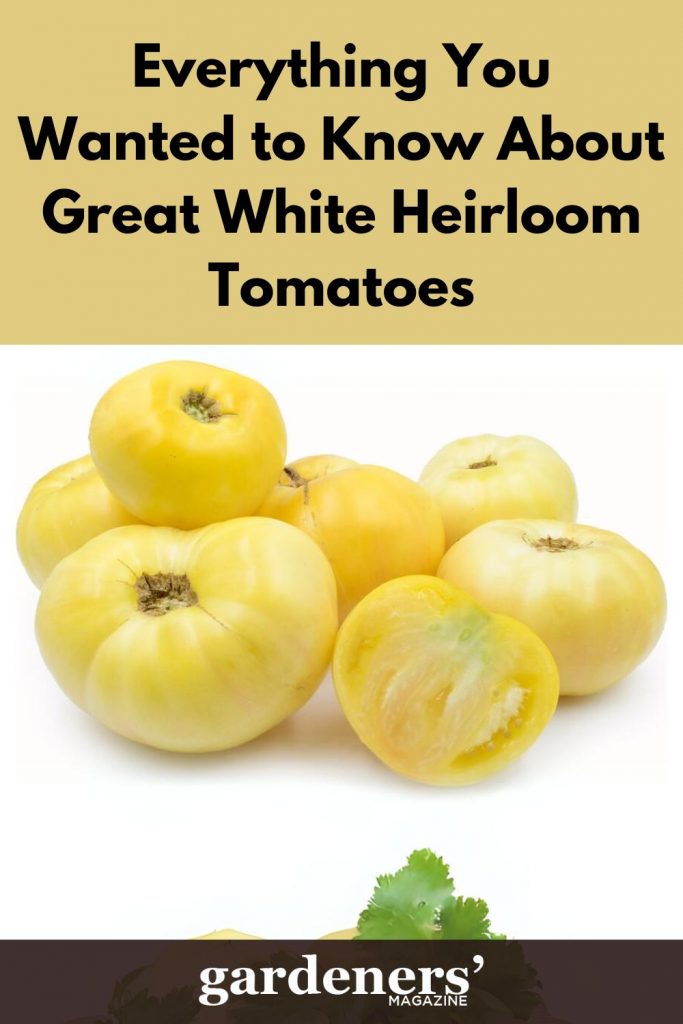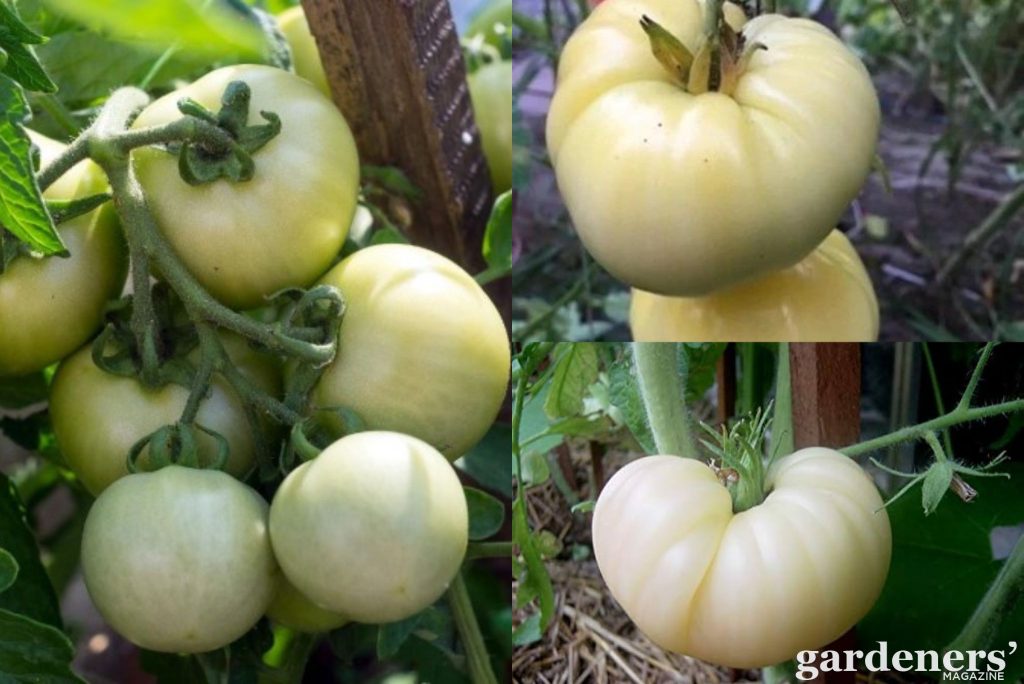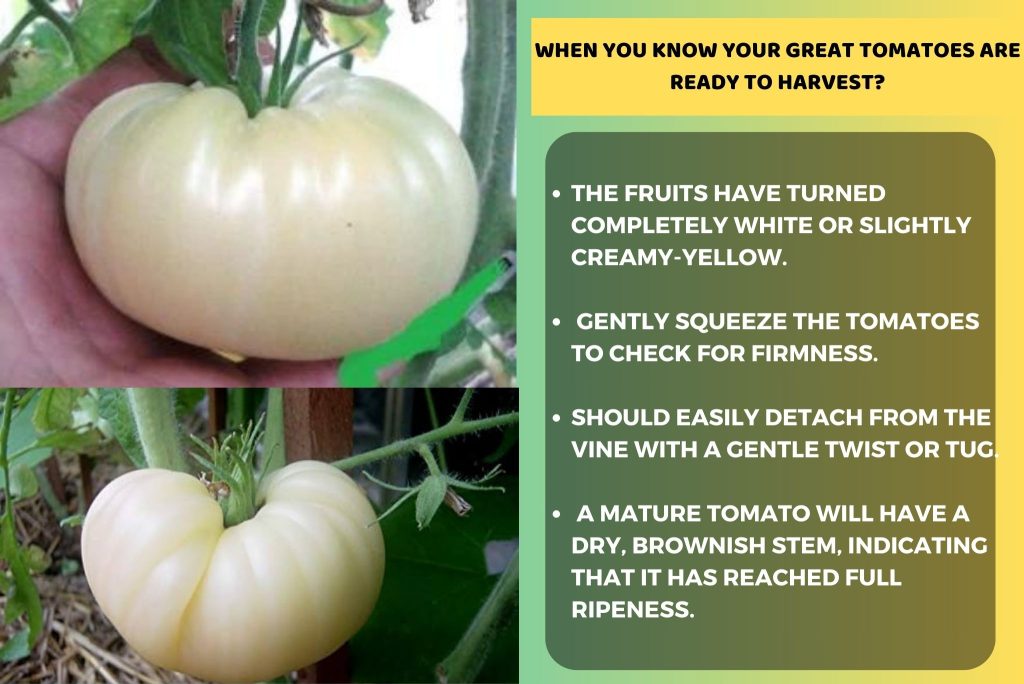Great White Heirloom Tomatoes are a unique and unusual variety of tomatoes, offering an interesting flavor profile that mixes tartness with sweetness. With its creamy ivory hue and rich, succulent flavor, the Great White Heirloom Tomato stands as a testament to the diversity and beauty found within the world of tomato cultivation.
Originating from generations of carefully preserved seeds passed down through time, this exquisite fruit boasts not only visual appeal but also a delightful taste that is both sweet and tangy. Whether enjoyed fresh off the vine, sliced onto sandwiches, or incorporated into gourmet dishes, the Great White Heirloom Tomato offers a culinary experience that embodies the essence of homegrown goodness and traditional gardening practices. Join us as we delve into the fascinating world of Great White Heirloom Tomatoes, exploring their history, cultivation, and culinary versatility.
So let’s get started!
What is a Great White Heirloom Tomato?
Great White Heirloom Tomatoes are a variety of tomatoes grown for hundreds of years. The name “great white” comes from the pale ivory color they have when ripe, hence their other nickname: ivory tomatoes. It belongs to the Solanum lycopersicum species and is classified as an heirloom tomato, meaning it has been passed down through generations of gardeners and seed savers. They are known for their unique flavor—a mix of sweet and tart—and a juicy texture that makes them perfect for salads, sauces, soups, and more.
Characterized by its smooth skin and meaty texture, the Great White Tomato typically grows to a size of around 1 pound or more, making it a substantial addition to salads, sandwiches, and culinary creations. Despite its name, the Great White Tomato may exhibit slight variations in color, ranging from creamy white to pale yellow, depending on factors such as growing conditions and ripeness

History and Origin of Great White Heirloom Tomatoes
The history and origin of Great White Heirloom Tomatoes trace back to the rich heritage of heirloom tomato cultivation. Believed to have originated in the United States, particularly in regions with a long history of tomato cultivation such as the Southeastern and Mid-Atlantic states, the exact origins of the Great White Tomato variety remain somewhat elusive. However, it is widely recognized as a cherished heirloom variety passed down through generations of gardeners and seed savers. The name “great white” comes from the pale ivory color they have when ripe, hence their other nickname: ivory tomatoes.
Since then, the Great White Heirloom Tomato has become popular in many countries worldwide. It is particularly beloved in North America, grown from coast to coast, and is a favorite of home gardeners and chefs alike. Its unique flavor—a mix of sweet and tart—and juicy texture make it an ideal ingredient for salads, sauces, soups, and more.
Description of Great White Heirloom Tomato
The Great White Heirloom Tomato is an oval-shaped, deep ivory-colored tomato. Its flesh is juicy and filled with small seeds. The tomatoes are typically about 5-7 centimeters, making them the perfect size for slicing or diving into salads or sauces. They also have a wonderful sweet-tart taste that pairs well with various dishes. When cooked, the tomatoes offer a creamy texture and a unique flavor that compliments many recipes beautifully.
When fully ripe, the Great White Heirloom Tomato exhibits a soft, succulent flesh that melts in the mouth, releasing a burst of refreshing juiciness. Its interior is often marbled with hints of pink or pale green, adding to its visual appeal. This tomato variety is versatile in the kitchen, lending itself well to a variety of culinary applications. Whether enjoyed fresh in salads, sliced onto sandwiches, or incorporated into sauces, salsas, and soups, the Great White Tomato adds a touch of elegance and flavor to any dish.

The Flavor Profile of Great White Heirloom Tomato
The flavor of the Great White Heirloom Tomato is often described as rich and succulent, with a juicy texture that enhances its eating experience. Unlike some tomato varieties that can be overly acidic or bland, the Great White Tomato strikes a perfect equilibrium, making it a versatile ingredient in both raw and cooked dishes.
In addition to its sweet and tangy notes, the Great White Heirloom Tomato may also exhibit hints of floral or citrus-like aromas, further enhancing its appeal. Its complex flavor profile makes it a popular choice among chefs and home cooks for a wide range of culinary applications, from salads and sandwiches to sauces, soups, and salsas. On top of that, the tomato’s flavor pairs beautifully with herbs like basil and oregano and cheeses like ricotta and mozzarella.
Health Benefits of Great White Heirloom Tomato
The Great White Heirloom Tomato offers not only a delightful flavor experience but also a plethora of health benefits. Packed with antioxidants like vitamin C, vitamin E, and beta-carotene, this variety contributes to overall well-being by combating oxidative stress, reducing inflammation, and supporting heart health.
Its rich lycopene content has been linked to lower LDL cholesterol levels and improved blood vessel function, promoting cardiovascular health. Additionally, the vitamin A in Great White Tomatoes supports vision and protects against age-related eye conditions. These tomatoes also boost the immune system with their high vitamin C content, aid in weight management due to their low calorie and high fiber content, and contribute to hydrated skin with their high water content.
Furthermore, the presence of vitamin K and calcium supports bone health, making Great White Heirloom Tomatoes a delicious and nutritious addition to any diet, promoting both culinary enjoyment and overall wellness. The Great White Heirloom Tomato is a healthy addition to any diet with its rich nutrient profile.
Seasonality and Availability Throughout the Year of Great White Heirloom Tomato
The Great White Heirloom Tomato is in season from June to August, with peak availability around July. However, the tomato can be found year-round at specialty farmers’ markets and greengrocers. They may also be available canned or frozen, depending on the store. When selecting this tomato for purchase, look for fruit that is firm and free of blemishes. The tomato should have a bright, ivory color and be slightly firm to the touch. Avoid any mushy or pale tomatoes, as they may not be at their peak of freshness.
Cultivation of the Great White Heirloom Tomato
- Location and Soil: Choose a planting site for Great White Heirloom Tomatoes that receives full sunlight for 6-8 hours daily. Ensure the soil is well-draining, nutrient-rich, and slightly acidic, with a pH level between 6.0 and 6.8. The Great White Heirloom Tomato is grown both in greenhouses and outdoors. Incorporate compost or aged manure to enhance soil quality and improve fertility and structure.
- Planting: Initiate the growth of Great White Tomato seeds indoors 6-8 weeks prior to the final frost date in your region. Once the soil has warmed and the threat of frost has passed, transplant the seedlings into the garden. Space the plants 18-24 inches apart within rows spaced 36-48 inches apart.
- Support: Provide structural support for Great White Tomato plants to prevent sprawling and encourage proper air circulation. Utilize stakes, cages, or trellises as options. As the plants develop, loosely tie them to the support structure using soft garden twine.
- Watering: Maintain consistent moisture levels in the soil without causing waterlogging throughout the growing season. Deeply and evenly water the plants, aiming for 1-2 inches of water weekly, adjusting based on weather conditions. Avoid getting the leaves wet when watering, as this may cause disease and rot.
- Fertilization: Apply a balanced fertilizer or organic compost to the soil during planting and subsequent fruit appearance stages. Avoid excessive nitrogen fertilization to prevent disproportionate foliage growth at the expense of fruit production.
- Pruning: Promote larger fruit production and enhance air circulation around Great White Tomato plants by removing suckers emerging from the leaf axils. Promptly prune any yellowing or diseased leaves to thwart disease spread.
- Mulching: Encourage moisture retention, weed suppression, and maintenance of consistent soil temperatures by applying organic mulch, such as straw or shredded leaves, around Great White Tomato plants.
Harvesting of the Great White Heirloom Tomato
The Great White Heirloom Tomato should be harvested when the fruit is ripe, usually two to four months after planting. When harvesting, it’s important to use gloves or pruners to protect the tomatoes from bruising.
- Determining Ripeness: Gauge the tomatoes’ readiness for harvest by examining their color and texture. Ripe Great White Tomatoes typically display a creamy-white to pale-yellow hue and yield slightly to gentle pressure when touched.
- Visual Assessment: Check the tomatoes for consistent coloration and firmness. Mature Great White Tomatoes should exhibit an even creamy-white or pale-yellow shade without any remaining green patches. Test their firmness by gently pressing them to ensure they are neither too soft nor too firm.
- Ease of Removal: Test the tomatoes’ readiness for harvest by attempting to detach them from the vine. Ripe tomatoes should separate easily from the plant with a gentle twist or tug. Avoid forcefully pulling them, as this may damage the plant and nearby fruits.
- Inspecting the Stem: Examine the stem of the tomato for signs of ripeness. A mature tomato typically features a dry, brownish stem, indicating optimal ripeness and readiness for harvest.
- Harvesting Technique: Employ sharp, clean pruning shears or scissors to harvest Great White Tomatoes. Snip the stem just above the fruit, leaving a small portion of the stem intact. This practice prolongs the tomatoes’ shelf life and reduces the risk of disease transmission.
- Handle with Care: Handle harvested tomatoes delicately to prevent bruising or skin damage. Place them in a shallow basket or tray lined with a soft cloth to cushion them during transportation.
Harvesting the Great White Heirloom Tomato is an easy and rewarding process. Not only will you enjoy their sweet, juicy taste, but they also make a great addition to any dish. Make sure to harvest regularly, as this will help encourage more fruit production from the plant. These tomatoes can last for several weeks or even months with proper care and storage.

Where Does Great White Heirloom Tomato Grow? Region-wise
Great White Heirloom Tomatoes are versatile in their adaptability to a range of climates worldwide, thriving in regions with warm temperatures and ample sunlight. Across the United States, they find success in states like Georgia, Florida, Alabama, and South Carolina, benefiting from extended growing seasons and abundant sunshine.
Similarly, in the Mid-Atlantic states such as Virginia, Maryland, and North Carolina, favorable climates and fertile soils support their cultivation. Despite challenges posed by arid conditions, Great White Heirloom Tomatoes can still be cultivated in the Southwest, including areas of Arizona, New Mexico, and Texas, with careful irrigation and soil management. California’s Mediterranean climate, particularly in locales like the Central Valley and coastal regions, provides an optimal environment for these tomatoes.
The plant requires full sun exposure for optimal growth and yields best when grown in well-drained soil with a pH between 6.0 and 7.5. The Great White Heirloom Tomato is also resistant to many common tomato diseases such as fusarium wilt, Verticillium wilt, and root-knot nematode.
What are the Things to Remember When Buying a Great White Heirloom Tomato?
When purchasing Great White Heirloom Tomatoes, prioritize appearance and texture. Opt for tomatoes with creamy-white to pale-yellow hues and smooth, unblemished skins, avoiding those with green patches or soft spots. Ensure the tomatoes feel firm yet yield slightly to gentle pressure when squeezed, indicating optimal ripeness.
Select tomatoes that feel heavy for their size, suggesting juiciness and freshness. Assess the stem end for a subtle, sweet aroma, indicative of ripeness and flavor. Look for tomatoes with dry, brownish stems, signifying proper harvesting and handling. Choose fruits that are uniform in size and shape for consistent ripening and cooking. Lastly, consider organic options to support sustainable farming practices and potentially reduce exposure to synthetic pesticides and fertilizers.
By considering these factors, you can confidently select the best-quality Great White Heirloom Tomatoes for your culinary creations.
What is the Best Way to Store Great White Heirloom Tomatoes?
Let me give you some storing tips for the Great White Heirloom Tomatoes.
- Store ripe Great White Heirloom Tomatoes in a cool, dry place like a pantry, away from direct sunlight.
- Wrap each ripe tomato individually in newspaper or paper towel to prevent bruising and maintain flavor and firmness.
- Place the wrapped tomatoes in a breathable container such as a paper bag.
- Keep unripe tomatoes in a shallow bowl or tray at room temperature until they ripen.
- Use the tomatoes soon after purchase or harvesting for best freshness.
- Regularly check the tomatoes for signs of spoilage like softness, mold, or excessive browning.
- Refrigerate any unused tomatoes within a few days for longer storage.
- Properly stored, ripe Great White Heirloom Tomatoes can last up to 5-7 days at room temperature and up to 10-14 days in the refrigerator.
How can Great White Heirloom Tomatoes be used in Recipes with Other Fruits and Vegetables?
Great White Heirloom Tomatoes are a versatile fruit used in many different recipes. They pair well with other fruits and vegetables, such as onions, garlic, peppers, mushrooms, carrots, apples, oranges, and bananas. They can be used in salads for a sweet and sour flavor or added to salsas for a delicious tangy kick. They also make a great side dish when roasted with herbs and spices.
Try grilling them with olive oil and balsamic vinegar topped with feta cheese for an easy summer meal. Great White Heirloom Tomatoes can be used to top a homemade pizza or tossed in pasta for a delicious dinner. Their sweet flavor and endless possibilities make them a great addition to any recipe.

Conclusion
Great White Heirloom Tomatoes are an excellent summertime fruit that can be enjoyed in many ways. In conclusion, these tomatoes stand out as a beloved variety cherished for their creamy-white to pale-yellow hue, exceptional flavor, and versatility in culinary applications. With their rich history, vibrant appearance, and delightful taste, these tomatoes continue to captivate gardeners and food enthusiasts alike.
Whether enjoyed fresh off the vine, sliced into salads, or incorporated into gourmet dishes, Great White Heirloom Tomatoes offer a delicious taste of tradition and a testament to the beauty of heirloom vegetable varieties. Their cultivation and appreciation highlight the importance of preserving agricultural heritage and celebrating the diverse flavors found in nature’s bounty.
- Everything You Wanted to Know About Red Tamarillos - June 2, 2025
- A Guide to Tulips: Everything You Need to Know & More… - June 2, 2025
- Guanabana: Description, Flavor, Benefits, And Uses - May 27, 2025
